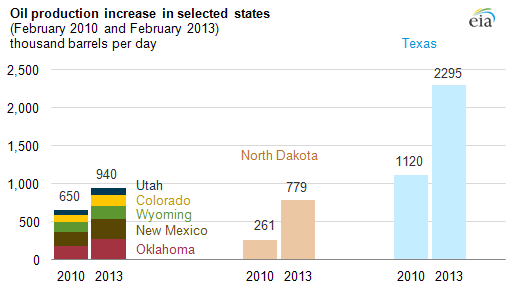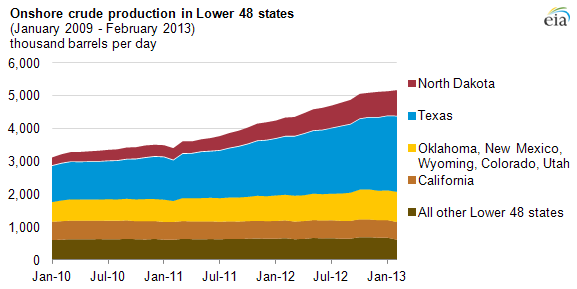
A number of western states increased oil production since 2010

Onshore oil production, including crude oil and lease condensate, rose more than 2 million barrels per day (bbl/d), or 64%, in the Lower 48 states from February 2010 to February 2013, according to recent estimates in EIA's Petroleum Supply Monthly.
The production growth that began in 2010 has continued, and while Texas and North Dakota have received a lot of attention for their production increases (Texas more than doubled its production, while North Dakota's output nearly tripled), there are other states where increases are noteworthy. Five western states in particular—Oklahoma, New Mexico, Wyoming, Colorado, and Utah—account for 15% of the increase. Production in each of these states increased between 23% and 64% over the same three years.
Lower 48 onshore production (total U.S. Lower 48 production minus production from the federal Gulf of Mexico and federal Pacific) increased between February 2010 and February 2013, primarily because of a rise in productivity from oil-bearing, low-permeability rocks. Although production increases in North Dakota's Williston Basin and Texas's Eagle Ford formation and Permian Basin outpaced other regions, gains in the other Lower 48 states add up to roughly 320,000 bbl/d of production over the past three years (290,000 bbl/d in the five states featured here).

Combined crude oil production in Oklahoma and New Mexico averaged more than 530,000 bbl/d in February 2013, about the same as California's February production. California is the fourth largest producing state after Texas, North Dakota, and Alaska. Oklahoma and New Mexico's gains in production, up 51% and 46%, respectively, compared with February 2010, are primarily from the Anadarko and Permian Basins. Wyoming and Colorado's production increased 23% and 64%, respectively; their top producing regions include the Powder River, Greater Green River, and Denver basins. Utah's production increased 45%, in part because of production from the recently discovered Covenant Field within the central Utah thrust belt, and ongoing production from the Uinta and Paradox basins.
In all of these states, increasing production was achieved by applying horizontal drilling and hydraulic fracturing to low-permeability rocks. In many fields (in basins such as the Permian, Uinta, and Powder River) enhanced oil recovery techniques such as CO2 injection are also boosting production from conventional reservoirs.